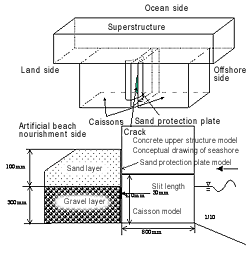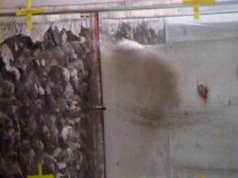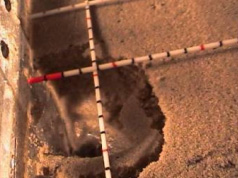2.Sediment runoff in artificial beaches
(1) Introduction
Coastal management from the viewpoint of user safety has become increasingly important. We therefore conducted experiments to identify the phenomena occurring underground and inside jetties, which are out of sight, to identify the state of sediment runoff in artificial beaches and to ensure the safe usage of beaches by local residents.
(2) Impermeable jetty structure
|
At many artificial beaches, multiple jetties are built and artificial beach nourishment materials are filled in between.
In the case of the jetties in Okura Beach, the superstructure is installed covering caissons of about 8 m in width, 10 m in length, and 4 m in height. Sand protection plates were built between the caissons to prevent the beach nourishment sand from running off into the sea, but the plates were damaged and the sand was carried off.
Accordingly, an experiment was conducted to reproduce this phenomenon using a model. This model was built roughly identical to Okura Beach on a scale of 1/10. Sand was placed at the upper part of the gravel layer with voids to make the structure similar to that of the artificial beach on site.
|

Conceptual drawing of model equipment
|
When the water surface was placid, the same configuration was maintained. However, when waves were applied, sand was intermittently carried away by the backrush waves through a slit (equivalent to the actual damaged section) made in the sand protection plate of the model, eventually leading to the creation of a cavity with vertical walls. When the beach nourishment sand became thin, the cavity reached the surface of the structure and caused a depression to form in it.
When the beach nourishment sand was thick, the cavity stopped developing and the cavity did not reach the surface. However, the upper surface of the cavity was covered with sediment, creating a trap for potential accidents. In the experiment, no major changes were observed on the structure surface until immediately before the surface depression.
|
 |
 |
| ySand run-offz |
yClose-up view of depression on the surfacez |
(3) Permeable jetty structure
Jetty bodies can roughly be classified into impermeable bodies such as the caisson structure and permeable bodies such as the rubble-mound structure.
Incidentally, the angle of repose of sand is approximately 30 degrees, and sand becomes stable at roughly 20% gradient (2 in the horizontal direction, 1 in the vertical direction). Accordingly, if the gradient of a jetty is sufficiently gentle, a stable sand slope is formed inside the permeable jetty, so whether or not the sand runoff stops when sufficient time has elapsed after completion of the jetty is the milestone for applying countermeasures. Thus, the phenomena inside the jetty were investigated.
A jetty model was built on a scale of 1/5 for a certain beach. As for the structure, gravel of 5 to 15 cm grain diameter was placed over the sand up to the height of 1.5 m with 20% gradient. The crest width was 0.6 m, the jetty body width 6.6 m, and water depth 1 m from the toe of the slope.
Under these conditions, sand was placed on the landward side, then the sand fell into the jetty body due to gravity, and a slope of approximately 10% gradient was formed underwater (
Figure A).
Subsequently, waves of 10 cm in height (equivalent to an actual wave height of 50 cm) were applied to the state of
Figure A, and waves were continuously applied to the body until the sand configuration stopped changing. Consequently, more sand ran off from the landward side, and the gradient of the sand surface of 10% as shown in
Figure A became approximately 15% as shown in
Figure B.
Figure C shows the results of applying waves of 20 cm in wave height (equivalent to an actual wave height of 1.0 m) to the state of
Figure B. The sand runoff progressed further, the beach nourishment sand reached the toe of the front slope, and then the beach nourishment sand ran off to the ocean side. It is assumed that the sand would continue to run off from the body under these conditions unless countermeasures were applied. The source of sand runoff was the intersection of the average water level and the back slope, and a depression occurred as shown in
Figure C.
Although the conditions of the water levels, wave heights, and other factors used in these model experiments are not necessarily applicable to all coasts, actual wave heights of 1 m are likely to occur at every beach, and so the condition shown in
Figure C is considered to occur at actual beaches.

Figure A Before wave generation

Figure B After wave generation (10 cm wave height)

Figure C After wave generation (20 cm wave height)
